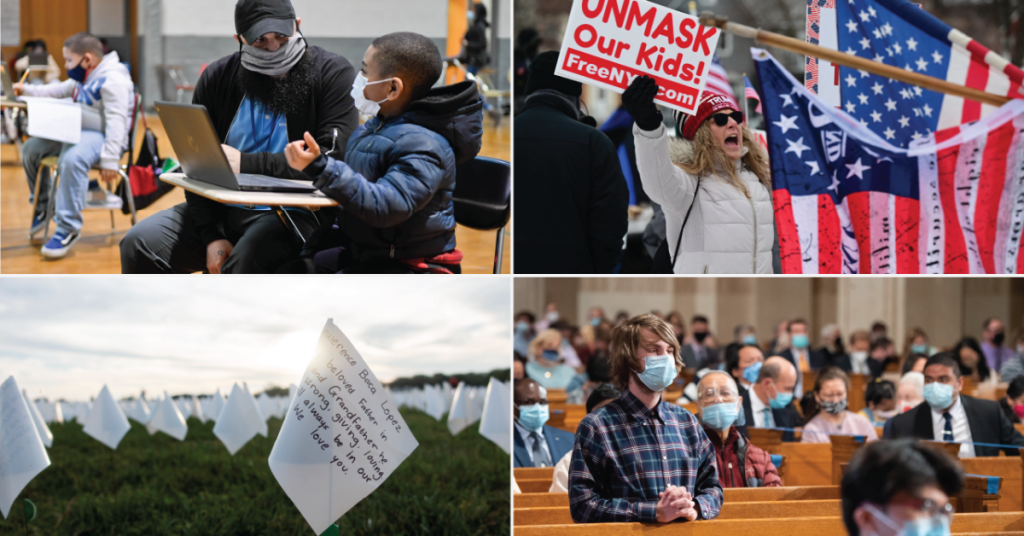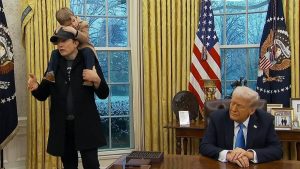Eileen Yam and Giancarlo Pasquini contributed to this chapter.
Five years after the pandemic began, Americans largely see COVID-19 through the rear-view mirror. Overall, they don’t feel the virus is nearly as much of a danger as they did in 2020. Still, deep political divides persist about the disease. Democrats and Republicans aren’t on the same page about how seriously we should be taking COVID-19 today. And the two parties hold different views on how well public health authorities and elected officials handled the pandemic.
Jump to read about views of COVID-19 today, including: Do Americans still see COVID-19 as a major threat? | How dangerous is COVID-19, and how seriously should we take it?
Jump to read about views on protecting others, including: What steps should people take to protect others when they’re sick? | How often do Americans wear masks?
Jump to read about past and future responses to health emergencies. Looking back: How do Americans think the country responded to the COVID-19 pandemic? | Looking ahead: How do Americans feel we would respond to a future health emergency?
Do Americans still see COVID-19 as a major threat?
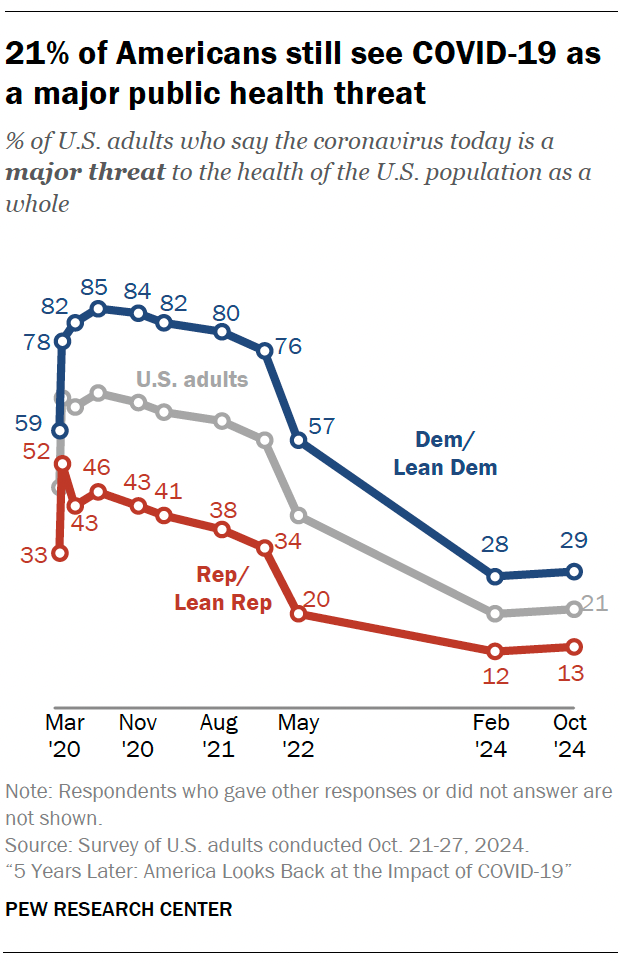
The COVID-19 pandemic was the deadliest in U.S. history. And many experienced the virus firsthand: In our survey, 63% of American adults say that since February 2020, they tested positive for the virus, were told by a health care provider they had it or are pretty sure they had it. With the public health emergency phase now behind us, we asked Americans if they feel the virus poses a threat today.
- About one-in-five Americans say the coronavirus today is a major threat to the health of the U.S. population as a whole. This is down from a high of 67% in July 2020.
- A larger share of Democrats and independents who lean Democratic (29%) than of Republicans and GOP leaners (13%) still see COVID-19 as a major public health threat. But now that the overall threat perception has dropped, the partisan gap is far less dramatic than it was in July 2020 (then 85% among Democrats, 46% among Republicans).
The share of Americans who say the coronavirus is a major threat to their personal health follows a similar pattern: There’s been an overall decline in the share of Americans who say this. And the partisan gap is less pronounced now that overall threat perception has dropped substantially. (Refer to the appendix for details.)
How dangerous is COVID-19, and how seriously should we take it?
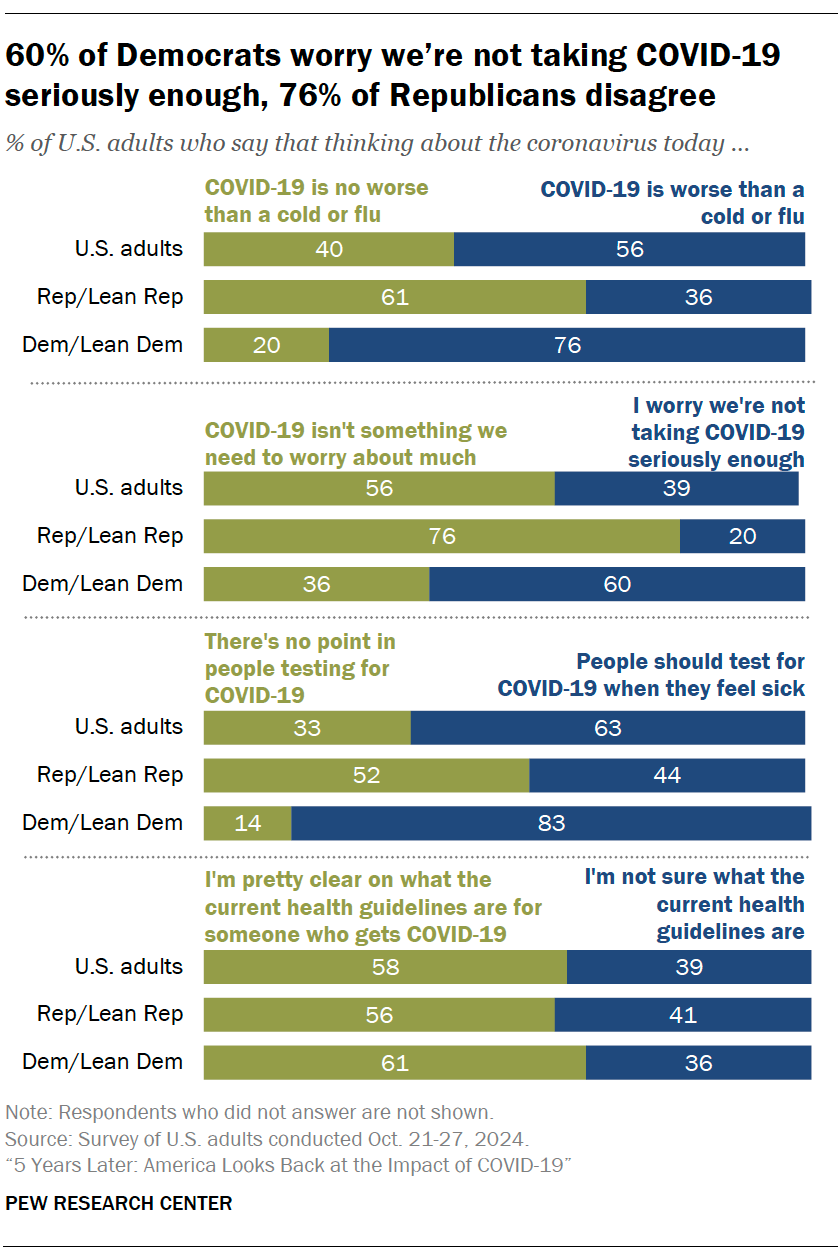
During the pandemic, scientists sounded alarms about how COVID-19 could be more lethal than a cold or flu. But there was fierce debate and widespread confusion about how severe the virus was, and what people should do about it.
How do Americans feel today about COVID-19’s severity, and how people should respond to it?
- Overall, 56% of Americans say COVID-19 is worse than a cold or flu, compared with 40% who say COVID-19 is no worse than these other illnesses.
- A small majority (56%) says COVID-19 isn’t something we need to worry about much. Still, about four-in-ten (39%) say we’re not taking it seriously enough.
- When it comes to testing for COVID-19, nearly two-thirds (63%) say people should take a test when they feel sick, compared with a third who say there is no point in doing this.
Differences by party
Republicans and Democrats differ dramatically in how they view COVID-19 today, with Democrats much more concerned about it. About three-quarters of Democrats (76%) say COVID-19 is worse than a cold or flu, compared with 36% of Republicans who say this. On the question of how worrisome the virus is, we see a similar partisan gap: About three-quarters of Republicans (76%) say COVID-19 isn’t something we need to worry about much, while 36% of Democrats say the same.
When it comes to whether people should test themselves for COVID-19 when they feel sick, a large majority of Democrats (83%) say people should test. But Republicans are much more split. About half (52%) say there’s no point in testing, while 44% say people should test.
Many Americans grappled with rapidly shifting health guidelines throughout the pandemic. Today, similar shares of both parties say they’re pretty clear on what the guidelines are for someone who gets COVID-19 (61% of Democrats, 56% of Republicans). But substantial minorities of both Democrats (36%) and Republicans (41%) say they are not sure what the current guidelines are.
Differences by race and ethnicity
Early in the pandemic, COVID-19’s health toll was especially heavy among Black and Hispanic adults. And in 2024, larger shares of Black (75%) and Hispanic Americans (64%) than White (51%) respondents say COVID-19 is worse than a cold or flu. This gap is driven by the much smaller shares of White Republicans who hold this view (33%). When we look just among Democrats, the racial and ethnic divide nearly vanishes: 80% of Black Democrats, 77% of Hispanic Democrats and 77% of White Democrats say COVID-19 is worse than a cold or flu.
What steps should people take to protect others when they’re sick?
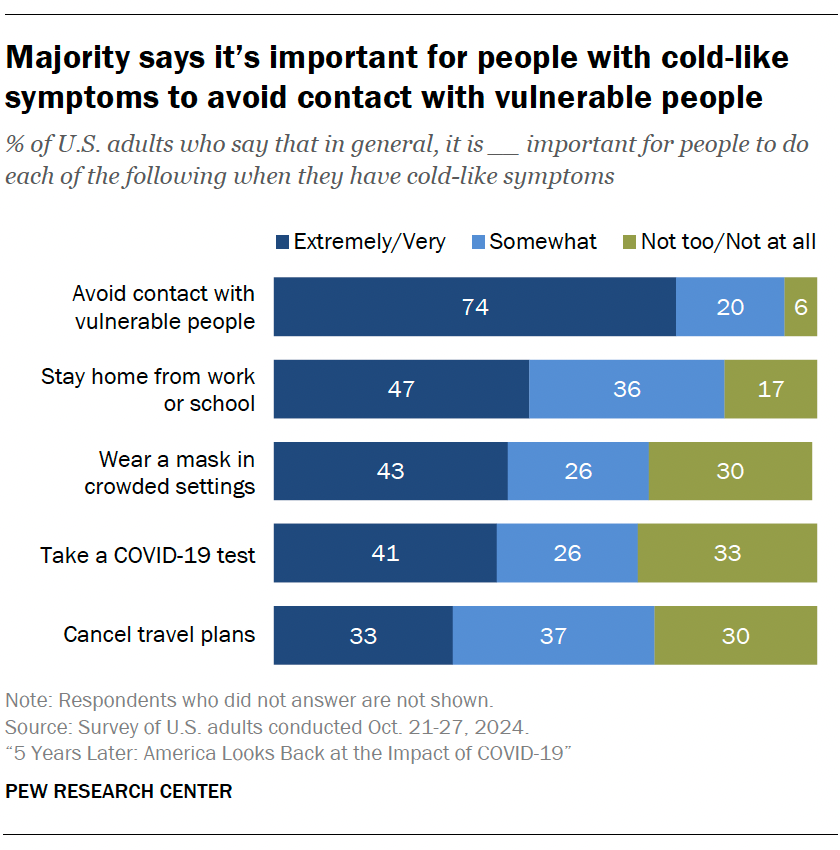
The Centers for Disease Control and Prevention (CDC) guidelines spell out several steps people can take to slow the spread of COVID-19 and other illnesses. Some of these guidelines – such as wearing a mask – became politically charged during the pandemic. Five years later, how do Americans feel about taking measures to prevent the spread of illness?
We asked Americans how important it is for people to take five different actions when feeling sick.
About three-quarters (74%) say it is extremely or very important for people with cold-like symptoms to avoid contact with vulnerable people, such as older people and pregnant women. Of the five actions we asked about, this is the one that respondents deem most important. Just 6% say this is not too or not at all important.
Americans feel much less strongly about other steps people can take to prevent spreading illness. Just under half (47%) of Americans say it is extremely or very important to stay home from work or school when feeling sick. About four-in-ten say the same about wearing a mask in crowded settings (43%) and taking a COVID-19 test (41%), while one-in-three say it is extremely or very important to cancel travel plans when feeling sick.
Still, a majority of Americans say each of these actions is at least somewhat important to do when people feel sick. No more than a third say that any of these five measures are not too or not at all important.
Differences by party
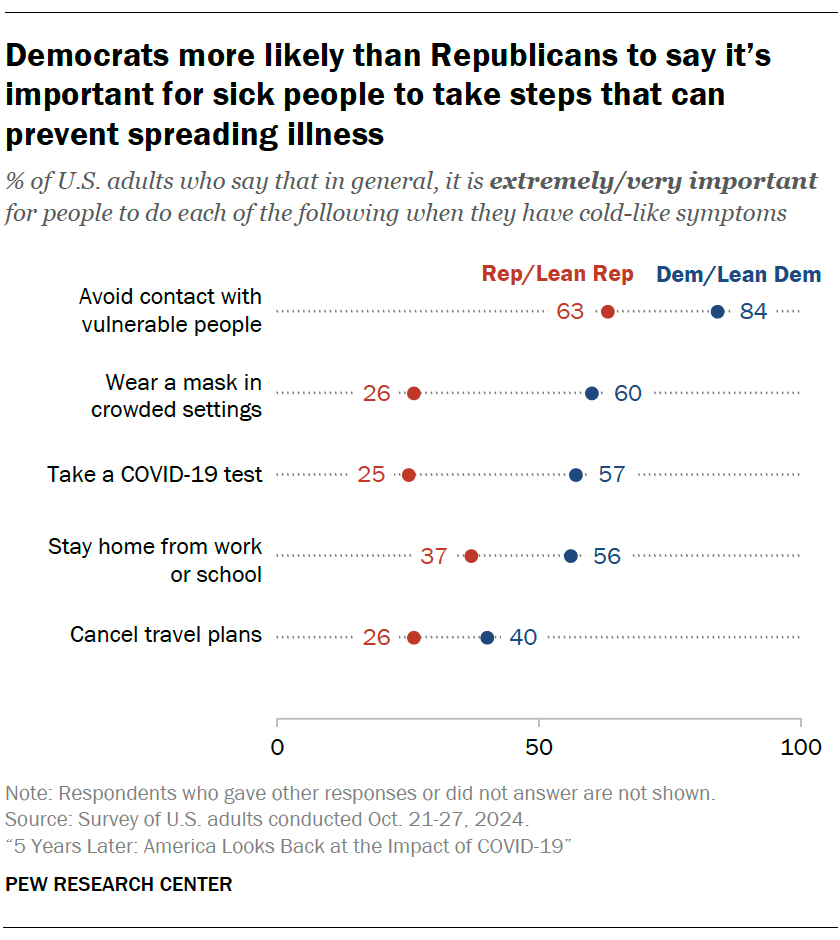
Larger shares of Democrats than Republicans feel these preventive actions are extremely or very important. The biggest partisan gaps emerge around mask-wearing and testing.
Six-in-ten Democrats say it’s extremely or very important to wear a mask in crowded settings when people have cold-like symptoms, compared with 26% of Republicans who say this. A similar share of Republicans (25%) say it’s extremely or very important to take a COVID-19 test, versus 57% of Democrats.
This partisan pattern holds for other behaviors that can prevent the spread of illnesses. For instance, majorities of both parties say it’s extremely or very important for people with cold-like symptoms to avoid vulnerable people. But this is a more widely held opinion among Democrats (84%) than Republicans (63%). Similarly, 56% of Democrats feel it’s extremely or very important for sick people to stay home from work or school, compared with 37% of Republicans.
How often do Americans wear masks?
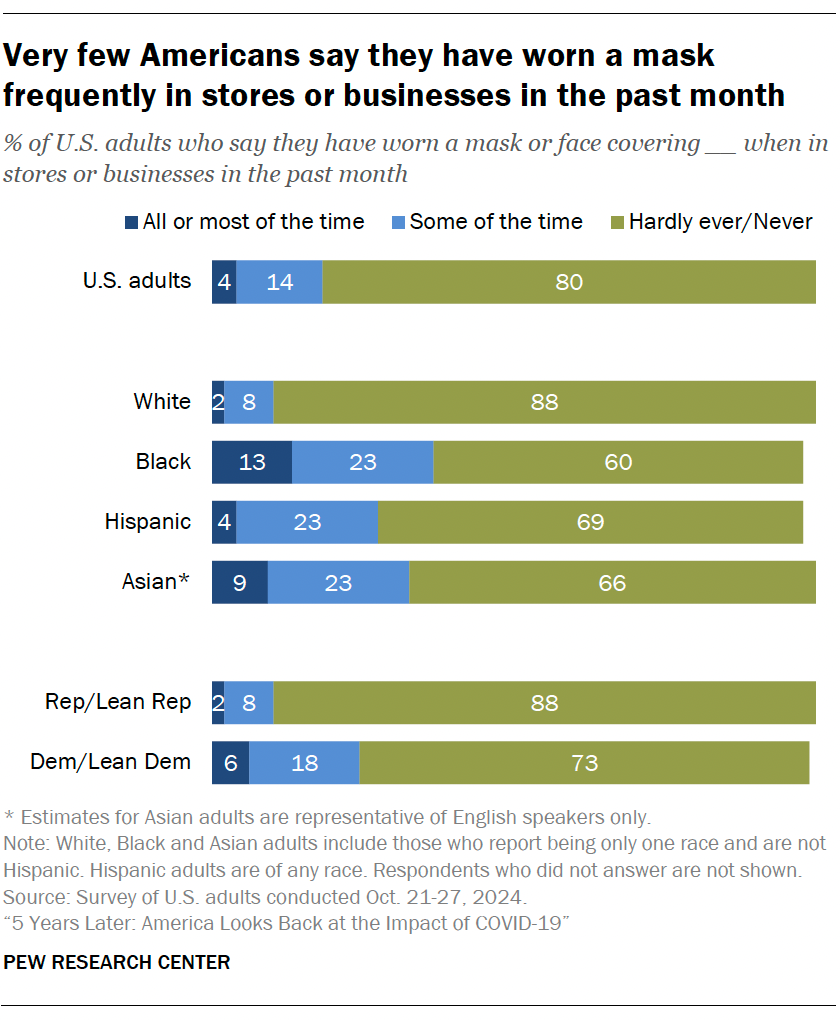
Face masks were a defining, intensely politicized symbol of the pandemic. Five years later, the vast majority of Americans (80%) say they rarely or never wear a mask in stores and businesses.
Overall, just 4% of Americans say they wore a mask or face covering in stores or other businesses all or most of the time in the past month. This is down from 88% about a year into the pandemic, and a majority (61%) were masking in stores as recently as January 2022.
In 2024, the small shares of Americans who wear a mask frequently are dwarfed by the 80% who say they hardly ever or never wear masks.
Differences by race and ethnicity
Larger shares of Black (36%), Hispanic (27%) and Asian Americans (32%) say they wore a mask at least some of the time in the past month than White Americans (10%). This pattern holds regardless of party: Among both Democrats and Republicans, White adults are less likely than Black, Hispanic or Asian adults to say they masked at least some of the time in the past month.
Partisan differences
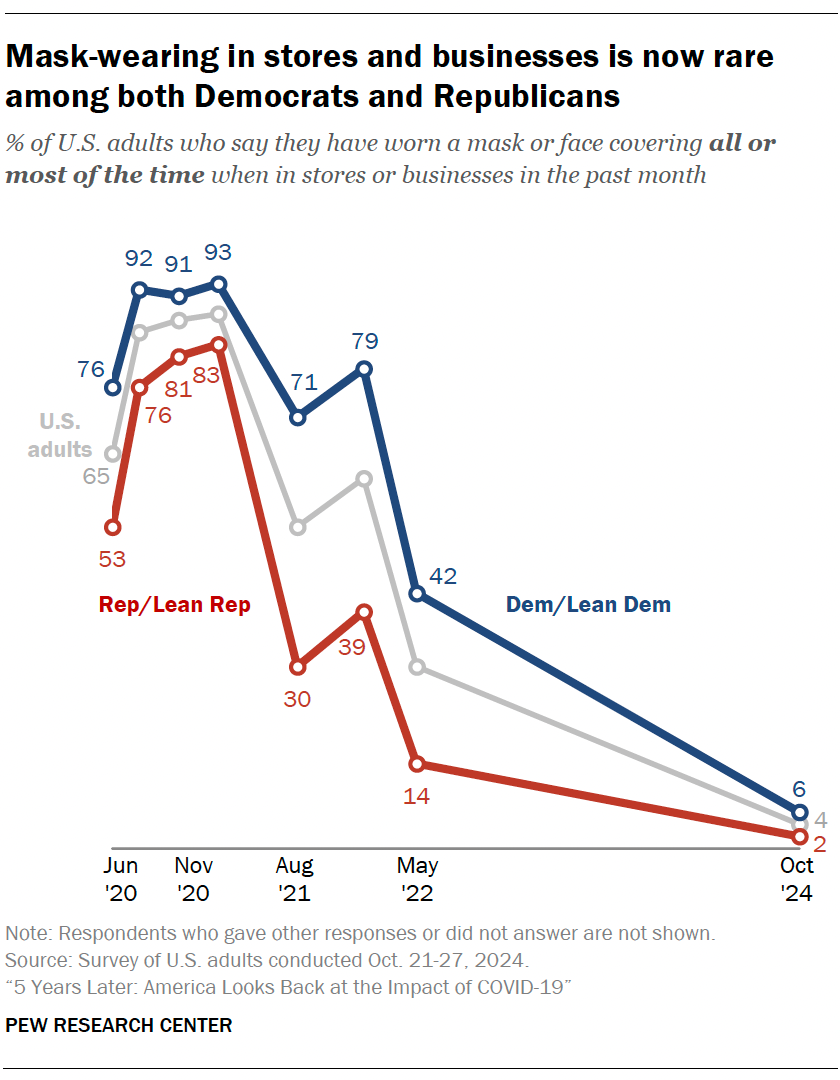
The share of Americans who report frequently wearing a mask in stores or businesses has declined dramatically since early in 2021. Frequent mask wearers are now so few and far between that the once-stark partisan gap has nearly disappeared.
Democrats and Republicans are now similarly unlikely to say they have frequently worn a mask in the past month (6% of Democrats and 2% Republicans say this).
When we last asked this question in 2022, there was a 28-point difference between the shares of Republicans (14%) and Democrats (42%) who said they wore masks all or most of the time.
Still, in the most recent survey, there are some differences between Republicans and Democrats when it comes to wearing a mask. For example, 76% of Republicans say they have never worn a mask in the past month, compared with 47% of Democrats who say this.
Looking back: How do Americans think the country responded to the COVID-19 pandemic?
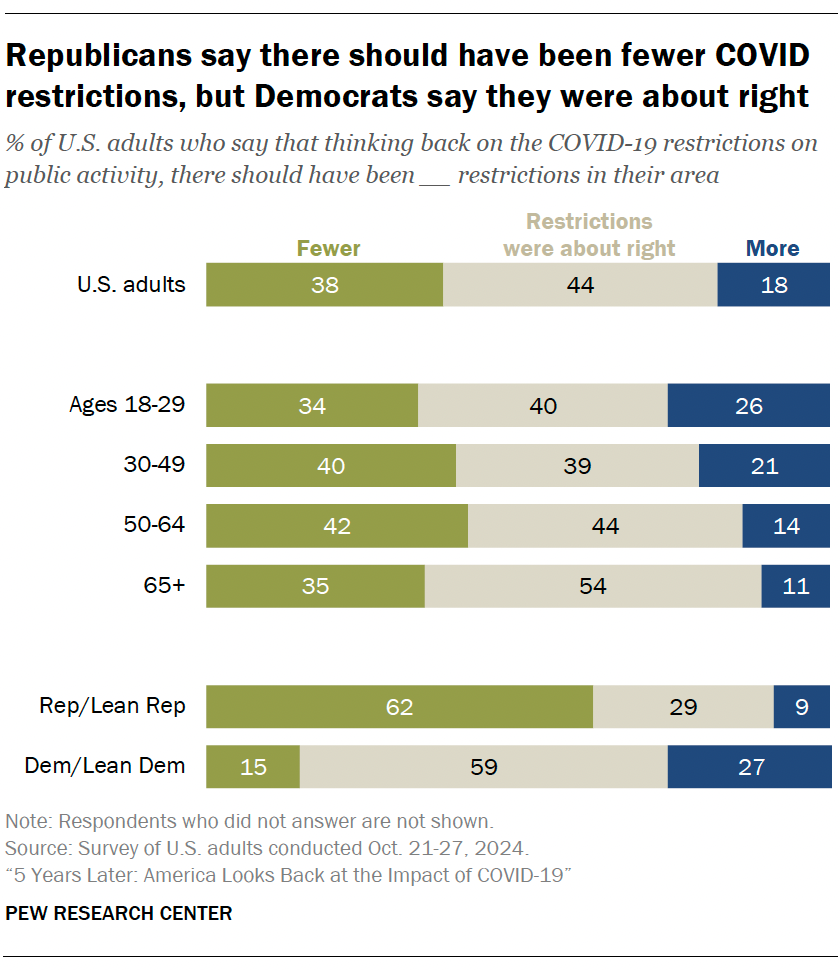
With five years of hindsight, we asked Americans how they now feel about COVID-19 policies that restricted public activity. We also asked about their views on how hospitals and government officials responded.
Views on pandemic-era restrictions
During the pandemic, authorities introduced various restrictions to slow the virus’ spread. For many Americans, these policies upended travel plans, schools, work and other aspects of life.
- Thinking back, 38% feel there should have been fewer restrictions on public activity in their area, compared with just 18% who say there should have been more restrictions. The largest share (44%) say the restrictions were about right.
- The view that there should have been fewer restrictions is much more pronounced among Republicans (62%) than Democrats (15%). More than half of Democrats (59%) feel the restrictions were about right, compared with 29% of Republicans.
- Adults ages 65 and older are more likely than younger adults to say restrictions were about right. In contrast, adults 18 to 29 are more likely than older adults to say there should have been more restrictions.
Views on how hospitals, public health officials and elected officials responded to the pandemic
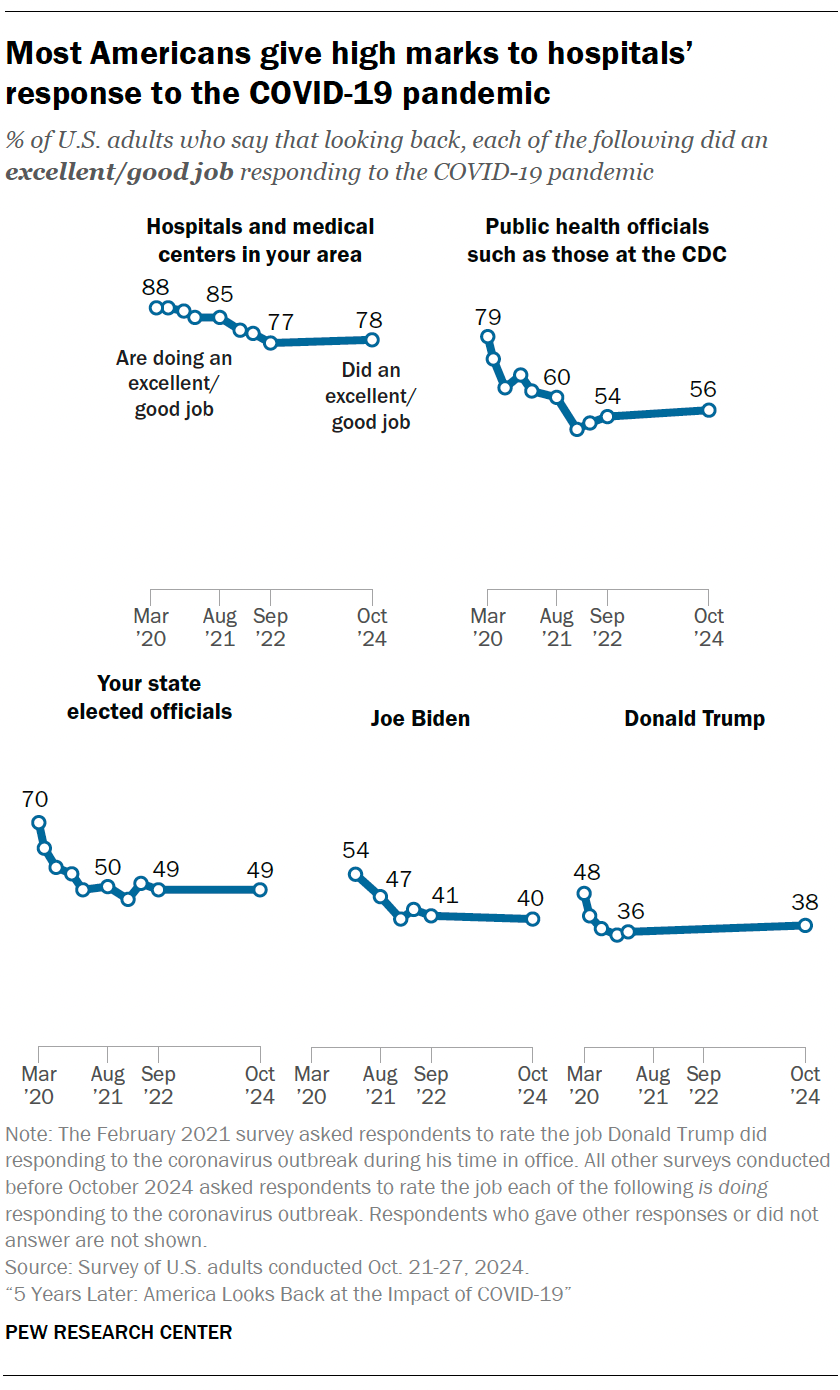
Hospitals and medical centers were on the front lines treating COVID-19 patients, and 78% of Americans look back and say they did an excellent or good job responding to the pandemic.
Views on the response of public health officials and elected officials are less positive. In the current survey, 56% of Americans say public health officials, such as those at the CDC, did an excellent or good job – much lower than the share who said this early in the pandemic.
For example, in March 2020, 79% of Americans said public health officials were doing an excellent or good job responding to the pandemic. By September 2022, that share was down to 54%.
Around half of U.S. adults (49%) now give positive ratings to how their state elected officials responded to the pandemic. At a national level, 40% say Joe Biden did an excellent or good job responding to COVID-19, and 38% say the same of Donald Trump.
Partisan differences
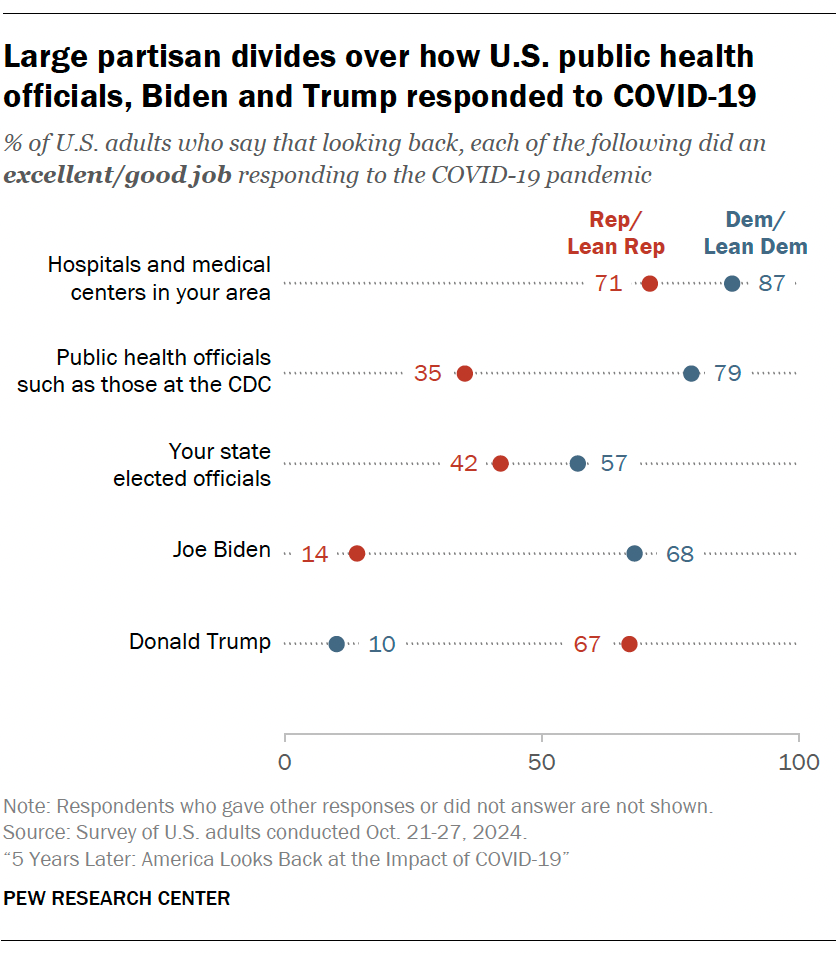
Looking back at the pandemic response, majorities of both Republicans (71%) and Democrats (87%) say their local hospitals and medical centers responded well.
In contrast, there’s a bigger partisan divide about how good a job public health officials did: A much smaller share of Republicans (35%) than Democrats (79%) give them high marks.
When asked about how Biden and Trump responded to the pandemic, Democrats and Republicans give reviews aligned with their partisan leanings. Among Democrats, 68% say Biden did an excellent or good job, compared with 14% of Republicans. But when asked to rate Trump, 67% of Republicans say he did an excellent or good job, versus 10% of Democrats.
Looking ahead: How do Americans feel we would respond to a future health emergency?
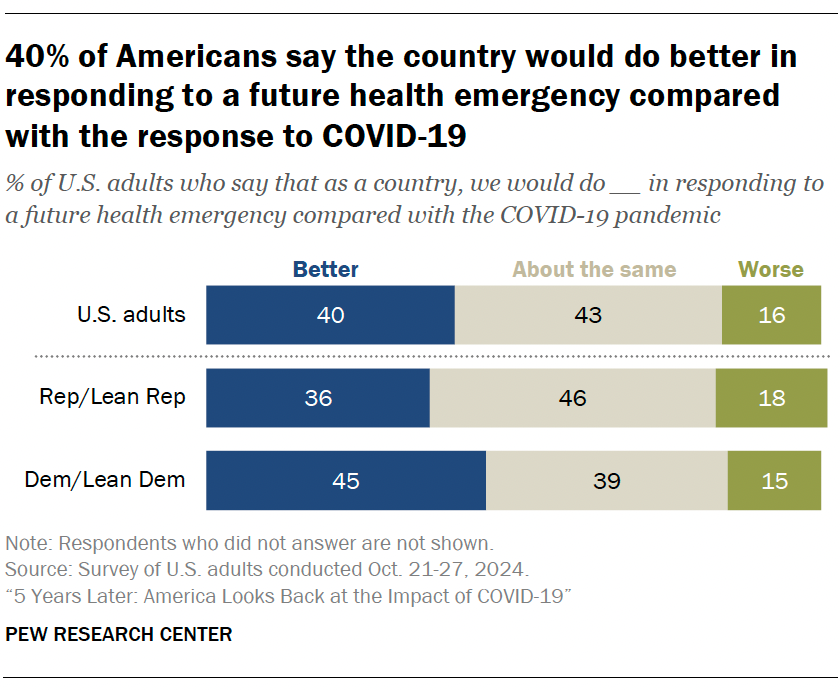
We also asked survey respondents how they think we would respond to a future health emergency compared with the response to the COVID-19 pandemic. These are views they expressed prior to the 2024 presidential election.
How would we do as a country?
Four-in-ten Americans are fairly positive about the prospect of a future health emergency response, saying that the country would do a better job responding compared with the COVID-19 pandemic. Just 16% feel the U.S. would do worse. And 43% say the country would do about the same.
Compared with how divided they are on other COVID-19 matters, Democrats and Republicans aren’t so far apart on this. Some 45% of Democrats and 36% of Republicans say the country would do better. Smaller shares of Republicans (18%) and Democrats (15%) say the country would do worse.
How well would the U.S. public health system and local communities deal with a future health emergency?
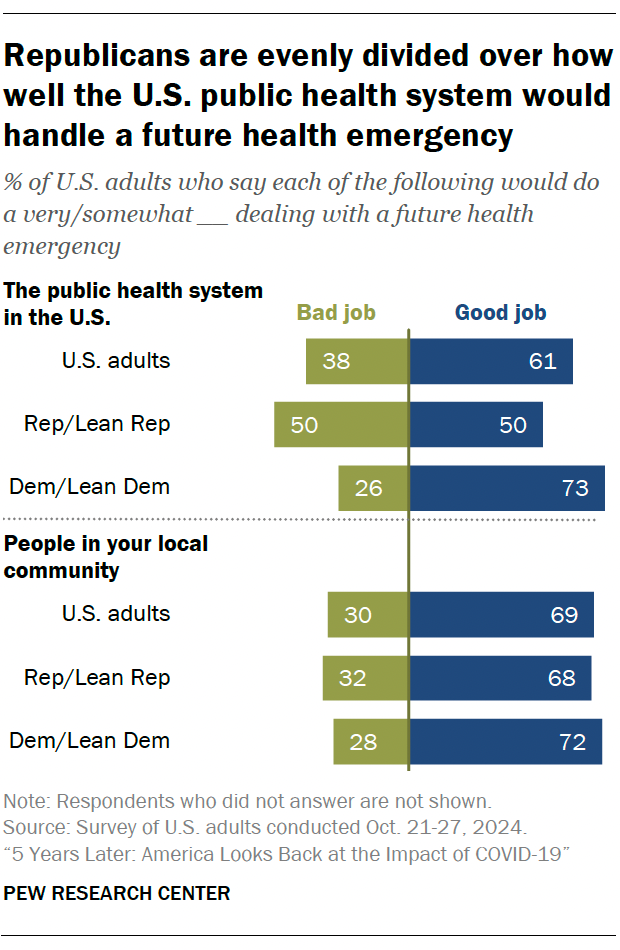
Both the U.S. public health system and people in local communities play a vital role in addressing health emergencies.
About six-in-ten Americans (61%) say the public health system would do a very or somewhat good job dealing with a future health emergency.
Democrats and Republicans differ on the future response of the public health system in the U.S. Among Democrats, 73% say it would do a good job and 26% say it would do a bad job. Republicans have more mixed views, with half saying it would do a good job and half saying it would do a bad job.
But when asked to think about people in their local community, Democrats and Republicans both have a positive outlook. Majorities of Democrats (72%) and Republicans (68%) say they would do a very or somewhat good job.



